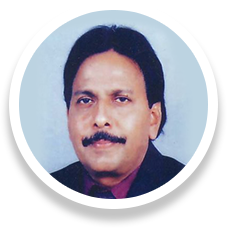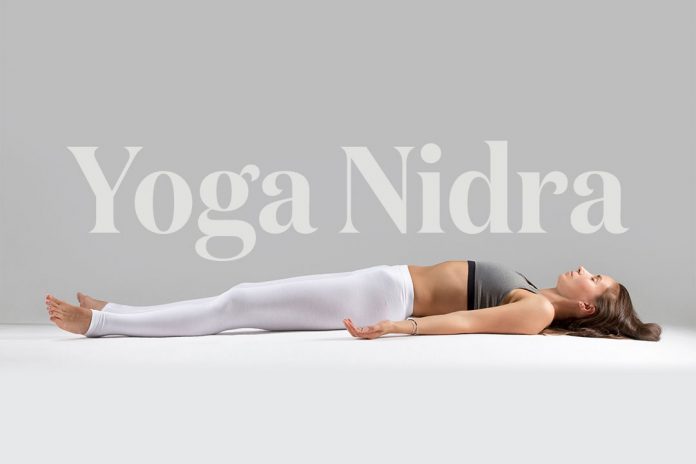Yoga Nidra is a yogic meditation for inducing perfect mental, physical, emotional and spiritual relaxation. It is almost similar to the progressive muscle relaxation technique, but it will give much deeper effect and impact on mind. It will strengthen your nerves and energize your body cells. It is found to be more effective than the Jacobson’s progressive relaxation widely used by psychologists for the treatment of mental tensions and anxiety related diseases.
Swami Sivananda popularized yoga nidra through the Bihar school of yoga. The amazing effect of yoga nidra has been proved by scientific research. The yoga nidra taught by the Bihar school of yoga is simple and scientific.
After regular yogic exercises and pranayamas you can practice yoga nidra or you can practice this separately in the early morning or before going to sleep. It’s better to practice it every day in the same place at the same time.
Three stages of Yoga Nidra
Totally half an hour is enough for practicing yoga nidra. In the first stage, you bring your awareness to each part of your body one after another. In the second stage you observe your natural breathing. In the third stage you visualize happy and beautiful scenes and mental pictures one by one. At the end, you can visualize your goals and say your resolution. All these stages help you to relax physically, mentally, emotionally and spiritually.
How to practice?
Select a room which is comfortable. Switch off your mobile phone. Take precautions to avoid all possible disturbances during the practice. Be very careful not to jump out of yoga nidra or do any sudden jerking movements.
You may lie down on a mat in savasana. Keep a comfortable position so that you can be motionless as far as possible during yoga nidra. Keep your eyes closed. Feel the calmness. Take a deep breath. Then you breathe out, mentally saying ‘relax.’
Bring your awareness to sounds you hear from a distance. Move your attention from sound to sound. Gradually bring your awareness to closer sounds. Be aware of your room. Be aware of your body lying motionless on the floor. Bring your attention to your natural breathe. Don’t try to concentrate but be simply aware of the natural process of breathing. Then say to yourself that you are going to be in deep yoga nidra. Then say mentally your resolution like ‘I am healthy or I am happy’ three times with feelings and full awareness. Resolution is a positive goal you want to achieve in your life.
Rotation of Consciousness
Rotation of your consciousness through the different parts of your body is an important stage. Move your awareness from one part to another quickly saying the name of each part mentally.
Right side
You can begin with the right hand. Right hand thumb, index finger, middle finger, ring finger, little finger, palm, wrist, elbow, shoulders, arm pit, waist, hip, right thigh, knee, calf muscle, ankle, heel, sole, right big toe, second toe, third toe, fourth toe, fifth toe.
Left side
Similarly repeat with the left side in the same order.
Back
Then bring your attention to the back side, then to right shoulder, left shoulder, right buttock, left buttock, the spine, the whole of the back together.
Front
Then come to front. Top of the head, forehead, right eyebrow, left eyebrow, eyebrow centre, right eye, left eye, right ear, left ear, right cheek, left cheek, nose, tip of the nose, upper lip, lower lip, chin, throat, right collar bone, left collar bone, right chest, left chest, middle of the chest, navel, abdomen, lower abdomen.
Then again bring your awareness to major parts of your body. Whole of the right leg, whole of the left leg, both legs together, whole of the right arm, whole of the left arm, both arms together, whole of the back, whole of the front, the head as a whole, the whole of the body together.
Breathing awareness
Now bring your attention to the natural breathing. Be completely aware of your respiration. Don’t try to force the breath, but simply be aware of it.
As you breathe in, feel that the body is expanding and as you breathe out feel that your body is relaxing. Exhale and relax the body. As you inhale feel that the body is filled with positive healing energy. As you exhale imagine that the impurities are expelled out of your system. Continue this for some time.
Visualization
Now start visualizing beautiful and relaxing scenes like full moon, blue sky, the rising morning sun, the colorful sky at the sunset, unending ocean, green mountains etc. After a few minutes of visualization, say your resolution mentally. Gradually bring your attention to your body and breathing. Be aware of your natural breathe. Your body is fully relaxed lying on the floor. Feel the deep relaxation. You are breathing in and out naturally.
Become aware of the surroundings. Be ready to move. Gently move your hands and feet. Gradually lift your head and sit up. Gently open your eyes, feeling fully relaxed. The practice of yoga nidra is now complete. Enjoy the relaxation with a smile.
Benefits of yoga nidra
- Reduces both physical and mental stress and anxiety
- Improves the quality of sleep
- Lowers your high B.P.
- Increases your vitality and vigor
- Helps to improve your concentration, focus and memory
- Aids to clear negative thoughts and to bring positivity
- Ensures your physical, mental, spiritual and emotional well being
- Enhances your love, empathy and compassion for self and for others
The renowned American writer, actor and producer, Emily Carpenter once revealed, ‘I practice yoga nidra to support my mental health and clear my mind space’. According to the famous yoga guru and author Swami Satyananda Saraswati, ‘Yoga nidra is the yoga of aware sleep. In this lies the secret of self healing’.
Cover Image Credits: Freepik

He is a Human Resource Consultant, National Trainer, and Counselor. Formerly he was the Deputy Chief Engineer, Kerala State Electricity Board and is still working as an external faculty of HRD Programmes of KSEB. He is also a faculty of Department of Management Studies, Mar Augusthinose College, Ramapuram, under M.G.University, Kerala. He is the PG course co-ordinator of MHRM.
He is a columnist in several Magazines, like ‘Business Deepika’, ‘Creative Business’, ‘Donbosco’ etc. His articles have been published in many magazines and journals. His several speeches have been aired by All India Radio. His interviews on various subjects have been telecasted by Power Vision TV.
He is the author of five best-selling books
- ‘Stress-Manassasthra- Aathmeeya Pariharangel’. (Current Books, Thrissur) 4th Edition
- Vijayiyude Vyakthithwam (Current Books, Thrissur)
- Jeevitham Santhushtamakan, Nithya Yauvanam Nedan.(CSS, Thiruvalla)2ndEdition
- Emotional Intelligence-Jeevithavijayathinu (CSS, Thiruvalla)
- Vijayarahsyangal (Current Books, Thrissur)
As a trainer, he has conducted more than a thousand seminars and workshops for teachers, parents, students, executives and others, on several subjects like Stress Management, Time Management, Personality Development, Emotional Intelligence and Spiritual intelligence for Excellence, Communicative Skills, Assertiveness, Motivation, Study Skills, Effective Parenting, Counselling Skills etc. He is an external training faculty of Power Engineers Training and Research Centre of KSEB. He is an external faculty of IMG Cochin. He is also the Secretary of Upasana Cultural Centre, Thodupuzha.




















